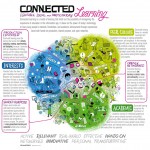Fresh from the Digital Media & Learning conference in San Francisco are two new web resources, Connected Learning and the Connected Learning Research Network. The work is centered around three learning principles and three design principles:
Learning principles
- Interest-powered. Interests power the drive to acquire knowledge and expertise. Research shows that learners who are interested in what they are learning, achieve higher order learning outcomes. Connected learning does not just rely on the innate interests of the individual learner, but views interests and passions as something to be actively developed in the context of personalized learning pathways that allow for specialized and diverse identities and interests.
- Peer-supported. Learning in the context of peer interaction is engaging and participatory. Research shows that among friends and peers, young people fluidly contribute, share, and give feedback to one another, producing powerful learning. Connected learning research demonstrates that peer learning need not be peer-isolated. In the context of interest-driven activity, adult participation is welcomed by young people. Although expertise and roles in peer learning can differ based on age and experience, everyone gives feedback to one another and can contribute and share their knowledge and views.
- Academically oriented. Educational institutions are centered on the principle that intellectual growth thrives when learning is directed towards academic achievement and excellence. Connected learning recognizes the importance of academic success for intellectual growth and as an avenue towards economic and political opportunity. Peer culture and interest-driven activity needs to be connected to academic subjects, institutions, and credentials for diverse young people to realize these opportunities. Connected learning mines and translates popular peer culture and community-based knowledge for academic relevance.
Design principles
- Shared purpose. Connected learning environments are populated with adults and peers who share interests and are contributing to a common purpose. Today’s social media and web-based communities provide exceptional opportunities for learners, parents, caring adults, teachers, and peers in diverse and specialized areas of interest to engage in shared projects and inquiry. Cross-generational learning and connection thrives when centered on common interests and goals.
- Production-centered. Connected learning environments are designed around production, providing tools and opportunities for learners to produce, circulate, curate, and comment on media. Learning that comes from actively creating, making, producing, experimenting, remixing, decoding, and designing, fosters skills and dispositions for lifelong learning and productive contributions to today’s rapidly changing work and political conditions.
- Openly networked. Connected learning environments are designed around networks that link together institutions and groups across various sectors, including popular culture, educational institutions, home, and interest communities. Learning resources, tools, and materials are abundant, accessible and visible across these settings and available through open, networked platforms and public-interest policies that protect our collective rights to circulate and access knowledge and culture. Learning is most resilient when it is linked and reinforced across settings of home, school, peer culture and community.
Infographic
Below is an infographic made by Dachis Group that highlights these essential components of connected learning. What if every learning environment was centered around these principles?
Dangerously Irrevelant Blog Post

